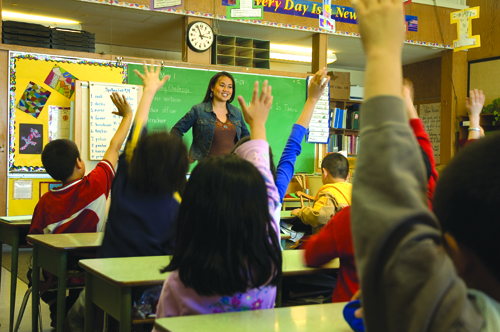Education Scenario Outcome

The region's future prosperity depends enormously on the quality of our education system. Seamless transitions are needed between early childhood education, K-12 education, and higher education, and all levels of education must be effective in providing children with the knowledge and skills that they need.
As a part of GO TO 2040's regional vision, our education system will prepare young people across the region to participate fully in society and be productively employed, regardless of race or economic background.
In coordination with an advisory committee of regional experts, the Illinois Action for Children, Ounce of Prevention, Voices for Illinois Children, University of Illinois at Chicago, and the University of Illinois, Institute for Government and Public Affairs have prepared general recommendations for actions to improve education within the long-term context of the GO TO 2040 plan. The recommendations cover:
Early childhood education
-
Metrics for school readiness
-
Adequate and effectively used resources
-
Use of best practices and most effective programs
K-12 education
-
Strategic plans for organizing education
-
Improving principal performance
-
Improving quality of instruction
-
Continuous data collection
Higher education
-
Close achievement and transition gaps
-
Address racial and ethnic disparities
-
Improve affordability of higher education
-
Improve transitions between community college, higher education, and the workforce
A report that provides more details on these recommendations is forthcoming and will be posted in this space when available; an executive summary is currently available.
Effect of physical planning decisions on education
Human service systems do not exist in a vacuum. The following questions are raised to spark discussion and thoughtful planning in our communities regarding the intersection of decisions we make about the physical infrastructure of our communities and education. Specifically, how will policies and financial investments about transportation, land use, housing, economic development, and the natural environment affect positively or negatively Education in our communities and in the region at large?
How would education be affected by different economic development policies: focusing on investments in human capital (improving the region's workforce); infrastructure (investing in physical infrastructure such as transportation facilities); or innovation (including but not limited to technological innovation)?
- Investments in human capital, with the intent of ensuring students have the knowledge and skills to lead fulfilling and productive lives, would support education goals. Developing knowledge and skills in our communities will support higher levels of capacity in the workforce.
- The use of technology in education could result in more effective learning and communications in classrooms, across schools, and with the broader society. Further use of online classes in both K-12 and higher education institutions could provide access to knowledge and learning opportunities that are not available locally.
- Regardless of the region's future economic profile and employment growth, a continued focus on problem solving, communication, and analysis is needed. We should not have two tiers of education standards, one for college bound students and one for non college goers. Increasingly, all work and life skills demand higher levels of learning for full participation.
How would education be affected by different transportation investment alternatives: focusing on major infrastructure investments (road or rail expansions); low-capital operational improvements (improved bus service, sidewalks, and trails); or technology (including real-time information or improved traffic signal timings)?
- Transportation investments that allow schoolchildren to walk to school would reduce the transportation expenditures of schools, a major component of their budgets. This would also likely improve the health of these children, which would have a direct positive impact on their educational performance. Small-scale improvements are more effective at this than major infrastructure or technology investments.
- Transportation also affects access to education. Making public transportation easily available to high schools, community college, and university would benefit students.
How would education be affected by different land use policies: focusing on dense, infill development; moderate densities with emphasis on community-centered design; or low-density new development?
- Location of schools can affect accessibility as well as the role of a school in a community. Denser development can centralize schools as community resources, letting them be used as community facilities outside of school-based activities. Long-term planning must take into account population needs at all levels of education.
- Reinvestment in currently underinvested neighborhoods would probably lead to increased economic activity, with positive impacts on school funding. Development that supports mixed-income housing would also reduce school segregation.
How would education be affected by different land conservation policies: focusing on preserving large areas of open space for biodiversity; providing parks for community access; or providing open space as part of new development?
- In dense areas, there are often shortages of parks and recreational areas, which contribute to poor health. Sharing of recreational space between schools and park districts is a possible way to address this issue. Healthier students miss less schooling and are likely to perform better.
How would education be affected by energy policies: focusing on adopting clean energy sources; reducing the energy consumption of buildings; or reducing the energy consumption of the transportation system?
- Energy-efficiency retrofits of schools can reduce operating expenses – and these budget savings could be directed toward other needs. "Green schools" may also provide learning opportunities for students that are not available in other schools.
How would education be affected by housing policies: preserving existing affordable housing; creating new affordable housing near transit and jobs; or reducing housing costs through energy efficiency improvements?
- Education can be improved by promoting affordable housing to be included as part of mixed-income neighborhoods, preventing overcrowding, and reducing segregation. There are also direct links between housing and education funding, which is heavily reliant on property tax; while funding is not the best predictor of educational quality and outcomes, it is certainly a factor.